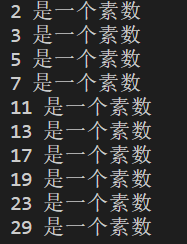Python循环语句
此文主要记录一些python循环语句区别其他高级语言(如c)的特性。
1.while循环
stack = ['1',2,'3',4,'5']
even = []
odd = []
while len(stack)>0:
temp = stack.pop()
if type(temp) == str:
temp = int(temp)
if temp%2 == 0:
even.append(temp)
else:
odd.append(temp)
print(even)
print(odd)
结果:

2.while循环使用else语句
在python中,while…else在循环条件为false时执行else语句块。
count = 7
while count > 5:
print(count)
count -= 1
else:
print(count)
结果:

3 .for循环
- python的for循环可以遍历任何序列的项目,如一个列表或者一个字符串。
s = 'apple'
for l in s:
print(l)
l = ['123','456','789']
for number in l:
print(number)

- 通过序列索引迭代
l = ['123','456','789']
for index in range(len(l)):
print(l[index])
结果:

补充:range()用法
Python3中的range()返回的是一个可迭代对象。
range(start,end,step)
start:默认从0开始,取便利的索引下标。
end:结束的索引下标,不包括end。
step:步长,在[start,end)范围内,每隔step步取一个元素。
- 循环使用else语句
for num in range(2,30):
for i in range(2,num):
if (num % i == 0):
break
else:
print("%s 是一个素数"%(num))
结果:

在c语言中需要设置flag才能解决的素数问题,在python中直接使用循环+else解决。
4.简单语句组
类似if语句的语法,若while循环中只有一条语句,可以将该语句与while写在同一行中。
flag = 1
while flag : print('flag is true') #无限循环中可以使用ctrl+c中断
print('88')
